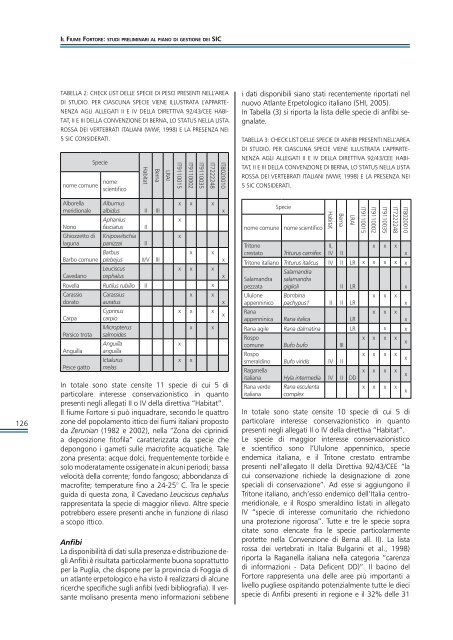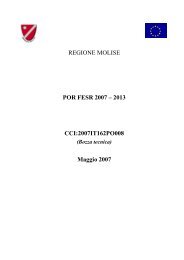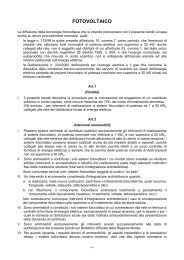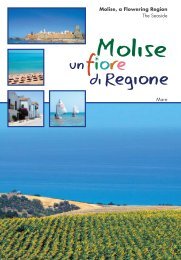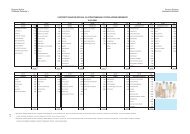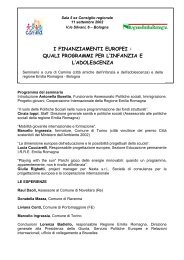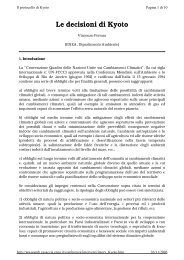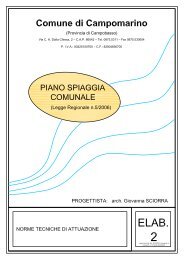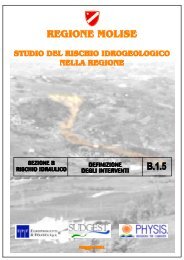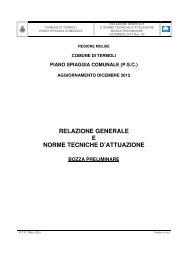Il fiume Fortore - Studi preliminari al piano di gestione dei SIC
Il fiume Fortore - Studi preliminari al piano di gestione dei SIC
Il fiume Fortore - Studi preliminari al piano di gestione dei SIC
You also want an ePaper? Increase the reach of your titles
YUMPU automatically turns print PDFs into web optimized ePapers that Google loves.
<strong>Il</strong> Fiu m e Fo r t o r e: s t u d i <strong>preliminari</strong> a l p ia n o d i g e s t io n e d e i <strong>SIC</strong><br />
126<br />
Tabella 2: Check List delle specie <strong>di</strong> Pesci presenti nell’area<br />
<strong>di</strong> stu<strong>di</strong>o. Per ciascuna specie viene illustrata l’appartenenza<br />
agli <strong>al</strong>legati II e IV della Direttiva 92/43/CEE Habitat,<br />
II e III della Convenzione <strong>di</strong> Berna, lo status nella Lista<br />
Rossa <strong>dei</strong> Vertebrati it<strong>al</strong>iani (WWF, 1998) e la presenza nei<br />
5 <strong>SIC</strong> considerati.<br />
nome comune<br />
Alborella<br />
meri<strong>di</strong>on<strong>al</strong>e<br />
Specie<br />
nome<br />
scientifico<br />
Habitat<br />
Berna<br />
Alburnus<br />
<strong>al</strong>bidus II III<br />
Aphanius<br />
fasciatus II<br />
Knipowitschia<br />
panizzai II<br />
Barbus<br />
plebejus II/V III<br />
Leuciscus<br />
ceph<strong>al</strong>us<br />
LRAI<br />
IT9110015<br />
IT9110002<br />
IT9110035<br />
IT7222248<br />
x x x<br />
x<br />
Nono<br />
Ghiozzetto <strong>di</strong><br />
x<br />
laguna<br />
x x<br />
Barbo comune<br />
x x x<br />
Cavedano<br />
Rovella Rutilus rubilio II x<br />
Carassio Carassius<br />
x x<br />
dorato auratus<br />
Carpa<br />
Persico trota<br />
Anguilla<br />
Pesce gatto<br />
Cyprinus<br />
carpio<br />
Micropterus<br />
s<strong>al</strong>moides<br />
Anguilla<br />
anguilla<br />
Ict<strong>al</strong>urus<br />
melas<br />
x x x<br />
x<br />
x<br />
x<br />
x<br />
x<br />
IT8020010<br />
In tot<strong>al</strong>e sono state censite 11 specie <strong>di</strong> cui 5 <strong>di</strong><br />
particolare interesse conservazionistico in quanto<br />
presenti negli <strong>al</strong>legati II o IV della <strong>di</strong>rettiva “Habitat”.<br />
<strong>Il</strong> <strong>fiume</strong> <strong>Fortore</strong> si può inquadrare, secondo le quattro<br />
zone del popolamento ittico <strong>dei</strong> fiumi it<strong>al</strong>iani proposto<br />
da Zerunian (1982 e 2002), nella “Zona <strong>dei</strong> ciprini<strong>di</strong><br />
a deposizione fitofila” caratterizzata da specie che<br />
depongono i gameti sulle macrofite acquatiche. T<strong>al</strong>e<br />
zona presenta: acque dolci, frequentemente torbide e<br />
solo moderatamente ossigenate in <strong>al</strong>cuni perio<strong>di</strong>; bassa<br />
velocità della corrente; fondo fangoso; abbondanza <strong>di</strong><br />
macrofite; temperature fino a 24-25° C. Tra le specie<br />
guida <strong>di</strong> questa zona, il Cavedano Leuciscus ceph<strong>al</strong>us<br />
rappresentata la specie <strong>di</strong> maggior rilievo. Altre specie<br />
potrebbero essere presenti anche in funzione <strong>di</strong> rilasci<br />
a scopo ittico.<br />
Anfibi<br />
La <strong>di</strong>sponibilità <strong>di</strong> dati sulla presenza e <strong>di</strong>stribuzione degli<br />
Anfibi è risultata particolarmente buona soprattutto<br />
per la Puglia, che <strong>di</strong>spone per la provincia <strong>di</strong> Foggia <strong>di</strong><br />
un atlante erpetologico e ha visto il re<strong>al</strong>izzarsi <strong>di</strong> <strong>al</strong>cune<br />
ricerche specifiche sugli anfibi (ve<strong>di</strong> bibliografia). <strong>Il</strong> versante<br />
molisano presenta meno informazioni sebbene<br />
x<br />
x<br />
x<br />
x<br />
x<br />
i dati <strong>di</strong>sponibili siano stati recentemente riportati nel<br />
nuovo Atlante Erpetologico it<strong>al</strong>iano (SHI, 2005).<br />
In Tabella (3) si riporta la lista delle specie <strong>di</strong> anfibi segn<strong>al</strong>ate.<br />
Tabella 3: Check List delle specie <strong>di</strong> Anfibi presenti nell’area<br />
<strong>di</strong> stu<strong>di</strong>o. Per ciascuna specie viene illustrata l’appartenenza<br />
agli <strong>al</strong>legati II e IV della Direttiva 92/43/CEE Habitat,<br />
II e III della Convenzione <strong>di</strong> Berna, lo status nella Lista<br />
Rossa <strong>dei</strong> Vertebrati it<strong>al</strong>iani (WWF, 1998) e la presenza nei<br />
5 <strong>SIC</strong> considerati.<br />
Specie<br />
nome comune nome scientifico<br />
Habitat<br />
Berna<br />
LRAI<br />
IT9110015<br />
IT9110002<br />
IT9110035<br />
IT7222248<br />
Tritone<br />
II,<br />
x x x<br />
crestato Triturus carnifex IV II<br />
x<br />
Tritone it<strong>al</strong>iano Triturus it<strong>al</strong>icus IV II LR x x x x x<br />
S<strong>al</strong>amandra<br />
pezzata<br />
Ululone<br />
appenninico<br />
IT8020010<br />
S<strong>al</strong>amandra<br />
s<strong>al</strong>amandra<br />
giglioli II LR x<br />
Bombina<br />
x x x<br />
pachypus1 II II LR<br />
x<br />
Rana<br />
x x x<br />
appenninica Rana it<strong>al</strong>ica LR<br />
x<br />
Rana agile Rana d<strong>al</strong>matina LR x x<br />
Rospo<br />
x x x x<br />
comune Bufo bufo III<br />
x<br />
Rospo<br />
x x x x<br />
smer<strong>al</strong><strong>di</strong>no Bufo viri<strong>di</strong>s IV II<br />
x<br />
Raganella<br />
x x x x<br />
it<strong>al</strong>iana Hyla interme<strong>di</strong>a IV II DD<br />
x<br />
Rana verde<br />
it<strong>al</strong>iana<br />
Rana esculenta<br />
complex<br />
x x x x<br />
In tot<strong>al</strong>e sono state censite 10 specie <strong>di</strong> cui 5 <strong>di</strong><br />
particolare interesse conservazionistico in quanto<br />
presenti negli <strong>al</strong>legati II o IV della <strong>di</strong>rettiva “Habitat”.<br />
Le specie <strong>di</strong> maggior interesse conservazionistico<br />
e scientifico sono l’Ululone appenninico, specie<br />
endemica it<strong>al</strong>iana, e il Tritone crestato entrambe<br />
presenti nell’<strong>al</strong>legato II della Direttiva 92/43/CEE “la<br />
cui conservazione richiede la designazione <strong>di</strong> zone<br />
speci<strong>al</strong>i <strong>di</strong> conservazione”. Ad esse si aggiungono il<br />
Tritone it<strong>al</strong>iano, anch’esso endemico dell’It<strong>al</strong>ia centromeri<strong>di</strong>on<strong>al</strong>e,<br />
e il Rospo smer<strong>al</strong><strong>di</strong>no listati in <strong>al</strong>legato<br />
IV “specie <strong>di</strong> interesse comunitario che richiedono<br />
una protezione rigorosa”. Tutte e tre le specie sopra<br />
citate sono elencate fra le specie particolarmente<br />
protette nella Convenzione <strong>di</strong> Berna <strong>al</strong>l. II). La lista<br />
rossa <strong>dei</strong> vertebrati in It<strong>al</strong>ia Bulgarini et <strong>al</strong>., 1998)<br />
riporta la Raganella it<strong>al</strong>iana nella categoria “carenza<br />
<strong>di</strong> informazioni - Data Deficent DD)”. <strong>Il</strong> bacino del<br />
<strong>Fortore</strong> rappresenta una delle aree più importanti a<br />
livello pugliese ospitando potenzi<strong>al</strong>mente tutte le <strong>di</strong>eci<br />
specie <strong>di</strong> Anfibi presenti in regione e il 32% delle 31<br />
x


